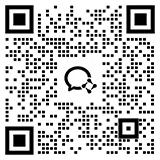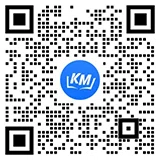
Previwas & Consulting
 language
language
[Interview] How does China Chemical Second Construction Group manage knowledge in the "Top 100 Competitiveness of China's Construction Industry"?
Release time:
2023-09-01 16:55
Author:
Blue Ling Software
China Chemical Engineering Second Construction Group Co., Ltd. (hereinafter referred to as "China Chemical Second Construction") is a wholly-owned subsidiary of China National Chemical Engineering Group Co., Ltd., which is managed by the State-owned Assets Supervision and Administration Commission of the State Council. The company was established in 1953 and is a large backbone enterprise in national petroleum and chemical engineering construction, with an annual construction production capacity of 20 billion yuan. The company has received multiple honors, including being one of the top 100 competitive enterprises in the construction industry and one of the top 100 enterprises in Shanxi Province.
Over the course of more than 60 years of development, China Chemical Second Construction has accumulated a wealth of knowledge achievements and project experience. How to better store and utilize these knowledge assets to support the innovative development of the business has been a topic of continuous reflection for China Chemical Second Construction. In 2021, China Chemical Second Construction partnered with Lanling to create a brand new knowledge management system. We are fortunate to invite Wang Xiaozhong, the relevant person in charge of the knowledge management department of China Chemical Second Construction, to share relevant project construction experience and insights in the field of knowledge management.
How to turn "intellectual property" into "assets" after more than 60 years of development
Q1: How do you view the importance of knowledge management for enterprises?
A: We often say that we are now in the era of knowledge economy, where knowledge is a valuable intangible asset for enterprises. Professor Chen Chunhua also proposed that "knowledge itself is productivity." Construction engineering enterprises are technology and knowledge-intensive enterprises, making effective knowledge management even more crucial. The role of knowledge management can be briefly summarized in eight words:
First is "energy storage," through knowledge management, organizational memory can be strengthened, allowing experiences to be better inherited;
Second is "energy utilization," enabling enterprises to have a comprehensive understanding of their affairs and avoid repeating mistakes;
Third is "energy enhancement," allowing new employees and frontline staff to quickly master job knowledge;
Fourth is "energy creation," aggregating collective wisdom to solve problems and create value.
Q2: Why did your company initiate the construction of a knowledge management project? What challenges did you face?
A:Since its establishment in 1953, the company has developed for more than 60 years, accumulating a wealth of knowledge achievements, project experience, and classic cases. We hope to further enhance the utilization of these knowledge assets, improve our knowledge innovation capabilities, and thus enhance our core competitiveness in the market. The challenges we faced at that time mainly included:
Project materials are relatively scattered: The process materials of each project are scattered among different project members, lacking a systematic approach, which may lead to the loss of materials;
Project results cannot be archived in a timely manner: Project materials and technical achievements cannot be stored online, affecting reuse efficiency;
Learning efficiency needs to be improved: There is a lack of mobile learning platforms, and employees hope to engage in online learning, mobile learning, and fragmented learning;
Data sharing is difficult: The process materials of various projects and the company's knowledge achievements cannot be interconnected in a timely manner, which is not conducive to the unified management of overall knowledge.
In light of the above challenges, we decided to initiate the construction of a knowledge management project, aiming to create a brand new knowledge management system to support the full-cycle management of knowledge accumulation, sharing, learning, application, and innovation.
Leveraging knowledge management to empower project operations and employee growth
Q3: Why did you choose to collaborate with Lanling? What were the main factors?
A:We evaluated several mainstream knowledge management vendors and ultimately chose to partner with Lanling for the project construction, mainly based on the following reasons:
● Over 20 years of professional accumulation: Lanling has over 20 years of experience in the field of knowledge management, is a participant in the formulation of national standards for knowledge management, and has successfully collaborated with many Fortune 500 and top industry enterprises;
● Professional knowledge management platform: They have a professional platform KMS, which has been market-tested and possesses multiple advantages such as advancement, reliability, scalability, ease of maintenance, security, and standardization;
●Mature consulting service system: Combining various domestic knowledge management methodologies, Lanling can provide complete consulting services for enterprises.
Considering all factors, we believe that Lanling has the capability to serve the multi-level knowledge management system of China Chemical Second Construction Group, centered on company control, secondary units, projects, etc., which is why we chose to partner with Lanling. The project collaboration has also proven that our choice was correct.
Q4: What main scenarios and functions does this project construction include? What value do the different scenarios bring to your company?
A:By establishing a brand new knowledge management system, the company can better accumulate and solidify knowledge assets, avoid knowledge loss, promote knowledge sharing, learning, utilization, and innovation, effectively reduce organizational operating costs, and enhance the core competitiveness of the enterprise. Specifically, it includes the following functions and values:
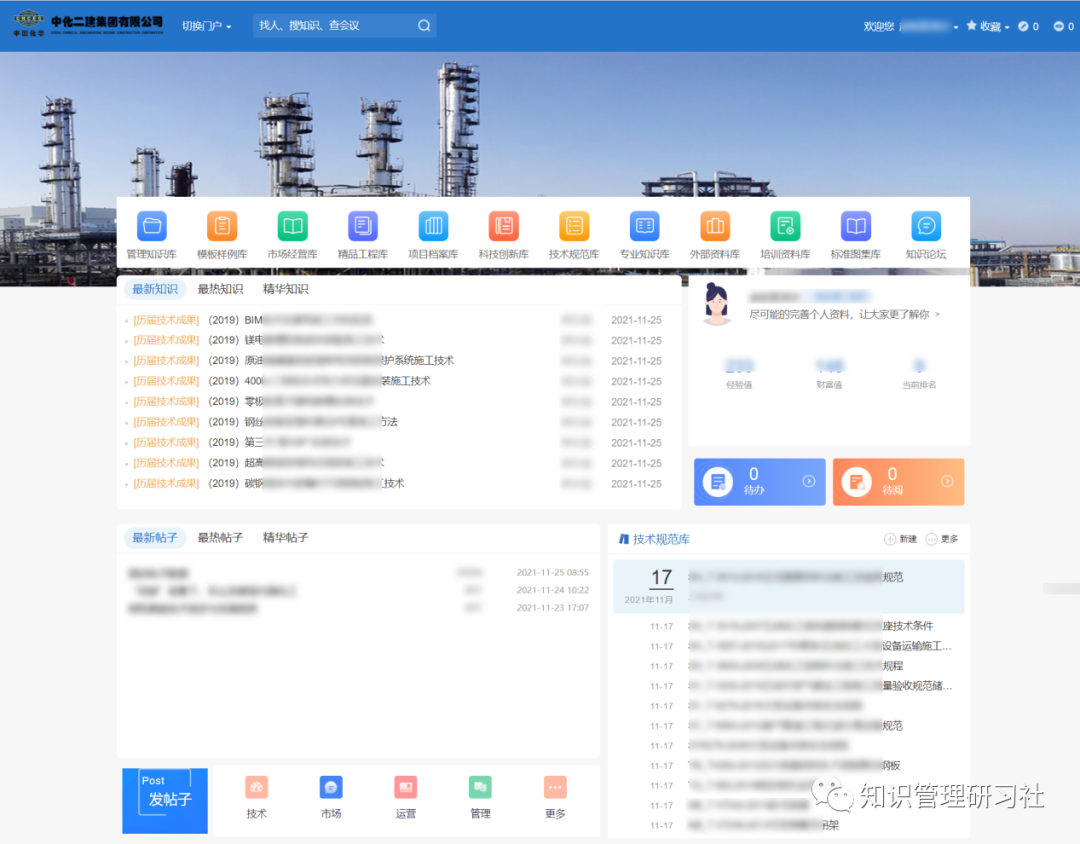
▲ Knowledge Portal
First, in terms of knowledge sources,for the four major modules of construction methods, technical processes, technological innovation processes, and intellectual property, we have realized the function of "pushing processes to the knowledge base," meaning that after project personnel submit processes and they are approved, the system automatically pushes the documents to the knowledge warehouse and project archive for knowledge storage.
Second, in terms of knowledge accumulation,we have built a knowledge warehouse, project archive, standard atlas, knowledge album, and project data library to solidify existing knowledge, making it convenient for everyone to learn at any time.
Knowledge Warehouse: Based on business types, we have formed a template sample library, excellent project library, technological innovation library, and other 10 major knowledge bases. Each knowledge base corresponds to the organizational structure, and we have completed the classification of knowledge bases; we have clarified reading, uploading, editing, and downloading permissions, knowledge attributes, and document approval processes to ensure the security and controllability of knowledge assets. As of now, various departments have uploaded a total of over 10,000 knowledge documents.
Project Archive: Mainly stores project topics, construction methods, intellectual property, papers, construction organization designs, construction plans, technical disclosures, engineering technology management summaries, and other project process assets.
Standard AtlasEstablish a standard atlas module to automatically fetch atlases from external websites to the system, allowing employees to consult and preview online at any time, saving a lot of time as they no longer need to search for atlases on external networks. So far, about 40,000 knowledge documents have been collected from external websites.
Knowledge AlbumCapture typical documents from the knowledge repository to form typical cases, displayed in the knowledge portal "Knowledge Album" section for employee learning.
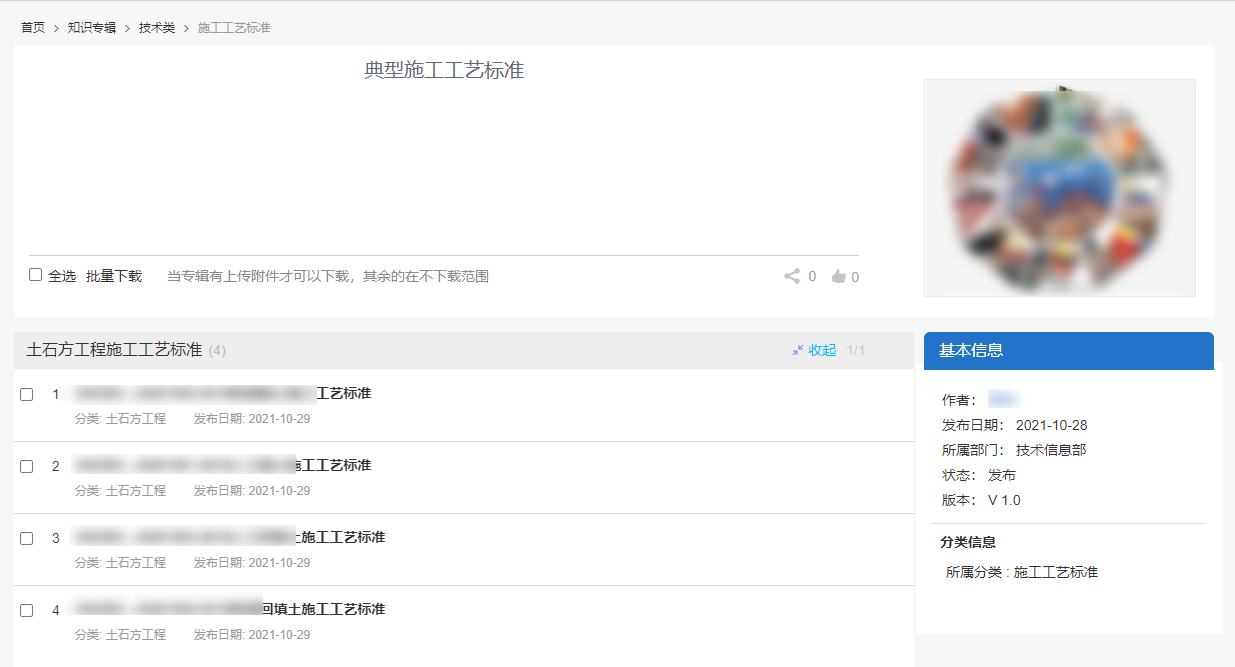
▲ Knowledge Album
Project Document LibraryA cloud drive for project personnel to store project documents, preventing file loss.
Thirdly, in terms of knowledge sharing and communication,a knowledge search, expert management, Q&A, and knowledge forum module have been built, allowing employees to quickly search for knowledge, find experts, ask questions, and share ideas, forming a unified platform for knowledge sharing and communication, enhancing work efficiency and strengthening corporate cohesion.
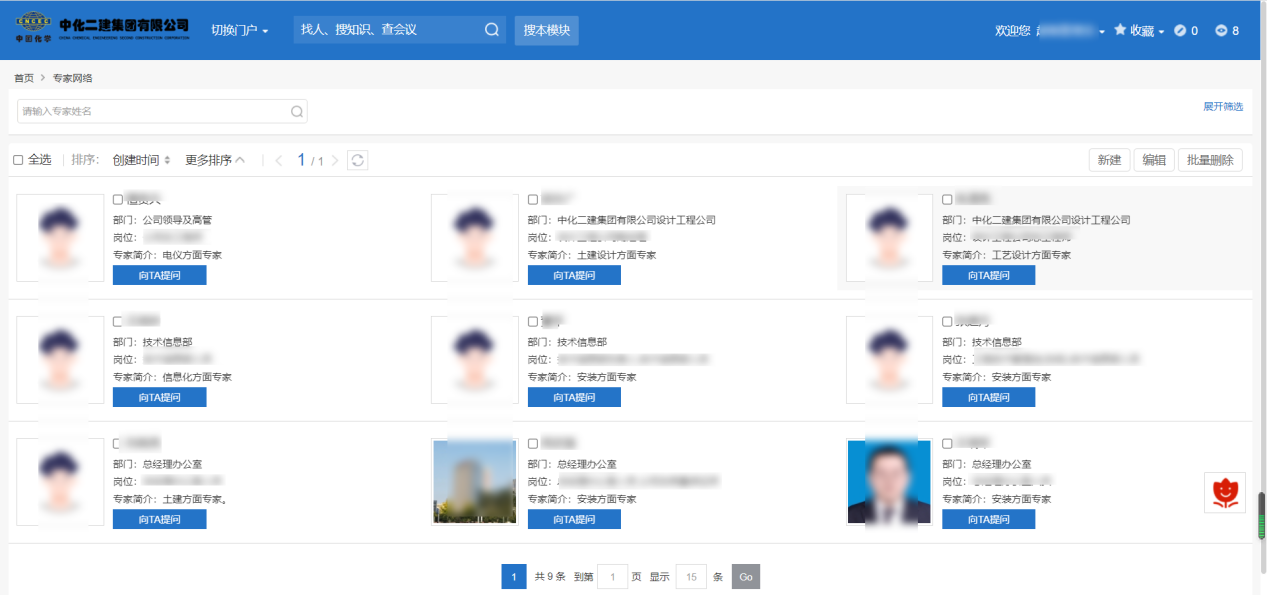
▲ Expert Network
Fourthly, in terms of knowledge achievements,knowledge statistics and points management applications have been constructed to help us effectively analyze the platform's operation, knowledge asset status, expert database, and personnel learning situation.
Q5: Overall, what changes and achievements has your company's knowledge management presented through this project?
A: 1. Improved organizational capability through information management.Construct a unified platform for knowledge, Q&A, knowledge albums, and knowledge forums, enabling employees to upload knowledge, ask questions online, post messages, and view albums, thus enhancing organizational capability.
2. Establish an online knowledge learning system for thousands of people:The system fully supports the entire group's online knowledge learning system, including 16 functional management departments, 22 secondary units, and over 200 projects, promoting internal knowledge sharing and data connectivity, conducive to unified knowledge management; build 10 major knowledge bases and standard atlas libraries for employees to learn knowledge at any time.
3. Improve learning efficiency and empower employee growth:Integrate mobile and corporate WeChat to achieve online learning, mobile learning, and fragmented learning, reducing learning costs and fully empowering employees to learn and grow.
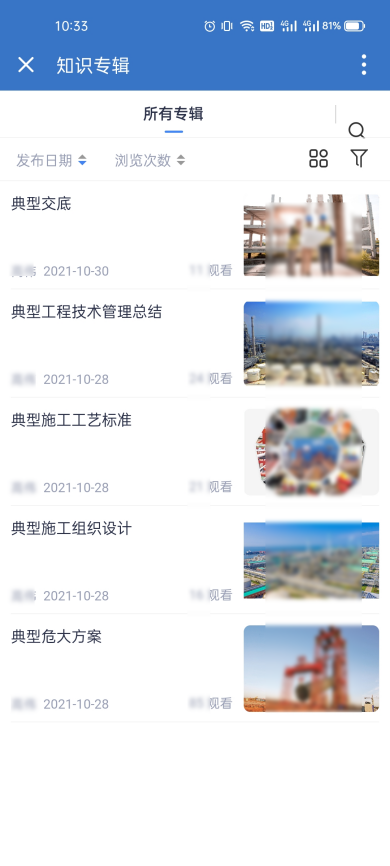
▲ Mobile Learning Interface
4. Effective management of the "Project Archive Library"Build a project archive library to store project process assets, standardizing, normalizing, scientific, and systematic project management, thereby regulating project implementation behavior and improving work quality.
Further promote knowledge management and build a learning organization.
Q6: In the future, what new deployments will your company's knowledge management work have, and what are the key work directions?
A:Since the knowledge management system went live, multiple functional departments, secondary units, and project personnel in the company have genuinely felt the convenience and value brought by knowledge management. In the future, we will promote knowledge management to more departments, secondary units, and related projects, striving to build a learning-oriented and knowledge-based enterprise. From the application of knowledge management, we will also focus on more applications such as knowledge maps and knowledge graphs, gradually upgrading the knowledge management system to better empower our enterprise and employees.




